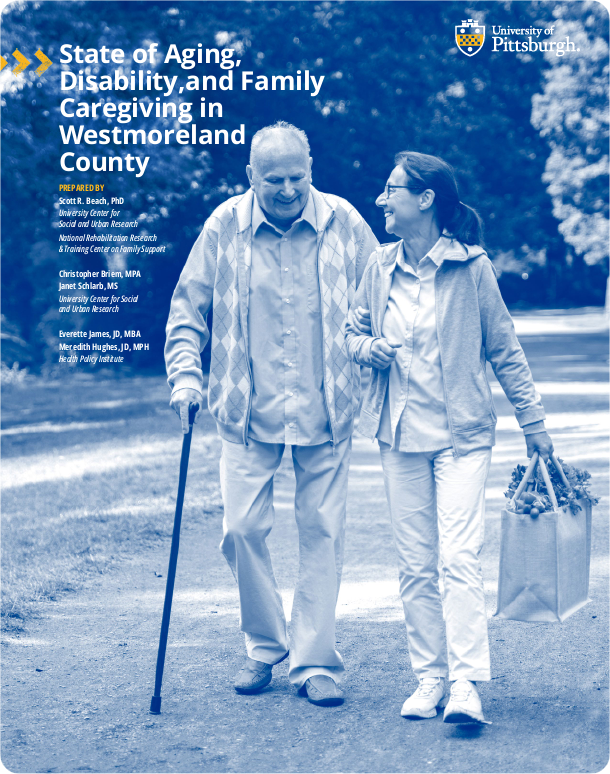· Study management &
data collection
· Graduate Certificate
in Gerontology
· Geographic Information Systems (GIS)
· Pittsburgh Regional Economic Model (REMI)
Back to Center Reports
State of Aging, Disability, & Family Caregiving
in Westmoreland County - November 2023

Understanding the characteristics of Westmoreland County’s aging residents and individuals with disabilities is critical to planning for a healthy and prosperous future for the country. While the broad demographics of the population being older with more prevalent disability than other U.S. counties is known, current detail on the perspectives of these individuals, their unmet needs, and socio-demographic and geographical disparities is lacking. Information on vulnerable sub-groups and key issues like housing, workforce participation, transportation, retirement savings, and access to healthcare and social supports is essential to informed program planning, policymaking, and resource allocation.
This report details findings from the 2023 State of Aging, Disability, and Family Caregiving in Westmoreland County project, funded by the Richard King Mellon Foundation. The study was conducted by the University Center for Social & Urban Research (UCSUR) and Health Policy Institute (HPI) at the University of Pittsburgh in partnership with various local organizations. Collaborating stakeholders include Westmoreland County Area Agency on Aging, PA Senate Majority Leader Kim Ward, AARP, Westmoreland County Transit Authority, Westmoreland Chamber of Commerce, Westmoreland Food Bank, The Provider Alliance, UPMC Senior Services, Laurel Faith in Action, Excela Health, Westmoreland County Industrial Development Corporation, and the University of Pittsburgh at Greensburg.
State of Aging, Disability, & Family Caregiving in Westmoreland County
November 14, 2023
Age-Friendly Community Index - Supplemental Report
Sample Demographic Characteristics
Age Breakout Summary
Presents data for key survey indicators for detailed age-subgroups, including all adults age 55 and older; all adults age 65 and older; and the following sub-groups: 55 – 54; 65 – 74; 75 and older.
Key for Items Below
Survey Toplines: Contain weighted frequencies on all original survey variables.
Detailed Graphs: Contain graphics showing breakdowns of all key survey indicators by socio-demographic variables; and disability, caregiving, and living alone status. Also, graphics showing sub-groups scoring highest / lowest (i.e., at greatest risk) on all key survey indicators.
Supplement
Supplement
Supplement
Supplement
Supplement
Supplement
Supplement
Supplement
Supplement
Supplement
Supplement
Supplement
Elder Mistreatment Endoursement
Supplement
Supplement
Supplement
Prepared By
• Scott Beach, PhD (UCSUR)
• Christopher Briem, MPA (UCSUR)
• Janet Schlarb, MS (UCSUR)
• Everette James, JD, MBA (HPI)
• Meredith Hughes, JD, MBA (HPI)
Funded By
Richard King Mellon Foundation
Collaborating Partners
- Westmoreland County Area Agency on Aging
- PA Senate Majority Leader Kim Ward
- AARP
- Westmoreland County Transit Authority
- Westmoreland Chamber of Commerce
- Westmoreland Food Bank
- The Provider Alliance
- UPMC Senior Services
- Laurel Faith in Action
- Excela Health
- Westmoreland County Industrial Development Corporation
- University of Pittsburgh at Greensburg
3343 Forbes Ave
Pittsburgh, PA 15260
ucsur@pitt.edu · 412-624-5442



